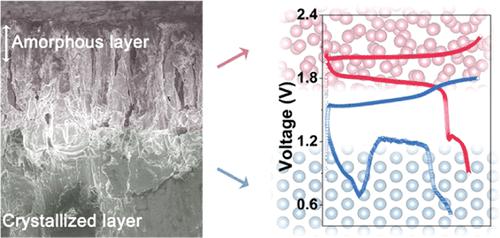当前位置:
X-MOL 学术
›
J. Am. Chem. Soc.
›
论文详情
Our official English website, www.x-mol.net, welcomes your feedback! (Note: you will need to create a separate account there.)
Reversible Al Metal Anodes Enabled by Amorphization for Aqueous Aluminum Batteries
Journal of the American Chemical Society ( IF 15.0 ) Pub Date : 2022-06-18 , DOI: 10.1021/jacs.2c04820 Chunshuang Yan 1, 2 , Chade Lv 1, 2 , Bei-Er Jia 2 , Lixiang Zhong 2 , Xun Cao 2 , Xuelin Guo 3 , Hengjie Liu 4 , Wenjie Xu 4 , Daobin Liu 2 , Lan Yang 2 , Jiawei Liu 2 , Huey Hoon Hng 2 , Wei Chen 5 , Li Song 6 , Shuzhou Li 2 , Zheng Liu 2 , Qingyu Yan 2, 6 , Guihua Yu 3
Journal of the American Chemical Society ( IF 15.0 ) Pub Date : 2022-06-18 , DOI: 10.1021/jacs.2c04820 Chunshuang Yan 1, 2 , Chade Lv 1, 2 , Bei-Er Jia 2 , Lixiang Zhong 2 , Xun Cao 2 , Xuelin Guo 3 , Hengjie Liu 4 , Wenjie Xu 4 , Daobin Liu 2 , Lan Yang 2 , Jiawei Liu 2 , Huey Hoon Hng 2 , Wei Chen 5 , Li Song 6 , Shuzhou Li 2 , Zheng Liu 2 , Qingyu Yan 2, 6 , Guihua Yu 3
Affiliation

|
Aqueous aluminum metal batteries (AMBs) are regarded as one of the most sustainable energy storage systems among post-lithium-ion candidates, which is attributable to their highest theoretical volumetric capacity, inherent safe operation, and low cost. Yet, the development of aqueous AMBs is plagued by the incapable aluminum plating in an aqueous solution and severe parasitic reactions, which results in the limited discharge voltage, thus making the development of aqueous AMBs unsuccessful so far. Here, we demonstrate that amorphization is an effective strategy to tackle these critical issues of a metallic Al anode by shifting the reduction potential for Al deposition. The amorphous aluminum (a-Al) interfacial layer is triggered by an in situ lithium-ion alloying/dealloying process on a metallic Al substrate with low strength. Unveiled by experimental and theoretical investigations, the amorphous structure greatly lowers the Al nucleation energy barrier, which forces the Al deposition competitive to the electron-stealing hydrogen evolution reaction (HER). Simultaneously, the inhibited HER mitigates the passivation, promoting interfacial ion transfer kinetics and enabling steady aluminum plating/stripping for 800 h in the symmetric cell. The resultant multiple full cells using Al@a-Al anodes deliver approximately a 0.6 V increase in the discharge voltage plateau compared to that of bare Al-based cells, which far outperform all reported aqueous AMBs. In both symmetric cells and full cells, the excellent electrochemical performances are achieved in a noncorrosive, low-cost, and fluorine-free Al2(SO4)3 electrolyte, which is ecofriendly and can be easily adapted for sustainable large-scale applications. This work brings an intriguing picture of the design of metallic anodes for reversible and high-voltage AMBs.
中文翻译:

用于水性铝电池的非晶化可逆铝金属阳极
水性铝金属电池(AMBs)被认为是后锂离子候选中最可持续的储能系统之一,这归因于其最高的理论体积容量、固有的安全运行和低成本。然而,水性AMBs的开发受到水溶液中无法镀铝和严重的寄生反应的困扰,导致放电电压有限,从而使水性AMBs的开发迄今为止未能成功。在这里,我们证明了非晶化是通过改变铝沉积的还原电位来解决金属铝阳极这些关键问题的有效策略。非晶态铝(a-Al) 界面层由低强度金属 Al 基底上的原位锂离子合金化/脱合金工艺触发。通过实验和理论研究揭示,非晶结构大大降低了 Al 成核能垒,这迫使 Al 沉积与电子窃取析氢反应 (HER) 竞争。同时,抑制的 HER 减轻了钝化,促进了界面离子转移动力学,并在对称电池中实现了 800 小时的稳定铝电镀/剥离。使用 Al@ a得到的多个完整单元格- 与裸铝基电池相比,铝阳极的放电电压平台增加了约 0.6 V,远远优于所有报道的水性 AMB。在对称电池和全电池中,优异的电化学性能是在无腐蚀性、低成本和无氟的 Al 2 (SO 4 ) 3电解质中实现的,该电解质环保且易于适应可持续的大规模应用。这项工作为可逆和高压 AMB 的金属阳极设计带来了一幅有趣的画面。
更新日期:2022-06-18
中文翻译:

用于水性铝电池的非晶化可逆铝金属阳极
水性铝金属电池(AMBs)被认为是后锂离子候选中最可持续的储能系统之一,这归因于其最高的理论体积容量、固有的安全运行和低成本。然而,水性AMBs的开发受到水溶液中无法镀铝和严重的寄生反应的困扰,导致放电电压有限,从而使水性AMBs的开发迄今为止未能成功。在这里,我们证明了非晶化是通过改变铝沉积的还原电位来解决金属铝阳极这些关键问题的有效策略。非晶态铝(a-Al) 界面层由低强度金属 Al 基底上的原位锂离子合金化/脱合金工艺触发。通过实验和理论研究揭示,非晶结构大大降低了 Al 成核能垒,这迫使 Al 沉积与电子窃取析氢反应 (HER) 竞争。同时,抑制的 HER 减轻了钝化,促进了界面离子转移动力学,并在对称电池中实现了 800 小时的稳定铝电镀/剥离。使用 Al@ a得到的多个完整单元格- 与裸铝基电池相比,铝阳极的放电电压平台增加了约 0.6 V,远远优于所有报道的水性 AMB。在对称电池和全电池中,优异的电化学性能是在无腐蚀性、低成本和无氟的 Al 2 (SO 4 ) 3电解质中实现的,该电解质环保且易于适应可持续的大规模应用。这项工作为可逆和高压 AMB 的金属阳极设计带来了一幅有趣的画面。

























 京公网安备 11010802027423号
京公网安备 11010802027423号